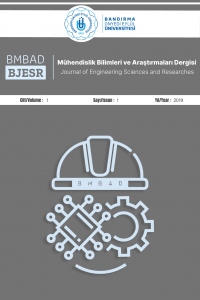Öz
Akciğer kanseri tüm Dünyada en sıklıkla
rastlanan ve hastalıklara bağlı ölümlerde birinci sırada yer alan bir kanser
türüdür. Bu noktada kolay uygulanabilen, yüksek doğrulukta sonuçlar üreten ve
mümkün olabildiğince az yan etkileri olan, erken evrede tanıya imkan tanıyan
yöntemlere ve cihazlara ciddi oranda gereksinim duyulmaktadır. Bu
çalışmada; akciğer kanserinin non-invazif yöntemler kullanılarak teşhis
edilebilmesi amacı için hasta ve sağlıklı bireylere ait nefes örnekleri gaz
sensör dizileri tarafından ölçülmüş ve sensör verileri analiz edilmiştir. Sekizi hasta olmak üzere toplam on yirmi dört
kişinin nefes örnekleri değerlendirilmiştir. Bu amaçla sensör verileri ön
işlemeye tabi tutularak her bir sensör için beş özellik hesaplanmıştır. Sensör
dizisinde kullanılan yedi sensörun verisi değerlendirmeye alınmıştır. Temel
bileşen analizi ile hasta verileri ve kontrol verilerinin dağılımı
incelenmiştir. Ayrıca sensör özelliklerinin sınıflandırmaya katkıları
değerlendirilmiştir. Sınıflandırma performansını belirlemek için, Doğruluk,
Spesifite ve Duyarlılık kullanılmıştır. Duyarlılığın yüksek olması hastaların
bulunmasının kolaylaşmasını ifade etmektedir. Kanser türü hastalıklarda
hastalığın tespit edilmesi çok önemlidir.
Anahtar Kelimeler
Destekleyen Kurum
TÜBİTAK
Proje Numarası
115E045
Teşekkür
Bu çalışma 1003 Öncelikli alanlar Ar-Ge projeleri destekleme programı kapsamında TÜBİTAK tarafından (Proje no. 115E045) desteklenmiştir.
Kaynakça
- [1] http://www.nanowerk.com/news/newsid=25441.php. 2014.[2] J. Ferlay, et al., "Estimates of worldwide burden of cancer in 2008: GLOBOCAN 2008", International journal of cancer, vol. 127, no. 12, pp. 2893-2917, 2010.[3] A.Jemal, et al., "Global cancer statistics", CA: a cancer journal for clinicians, vol. 61 no. 2, pp. 69-90, 2011. [3] Y. Chu, F. You, J. M. Wassick, and A. Agarwal, “Integrated planning and scheduling under production uncertainties: Bi-level model formulation and hybrid solution method,” Computers and Chemical Engineering, vol. 72, pp. 255–272, 2015.[4] O. Er, A.C. Tanrikulu, A. Abakay, F. Temurtas, "An approach based on probabilistic neural network for diagnosis of Mesothelioma’s disease", Computers & Electrical Engineering, vol. 38 no. 1, pp. 75-81, 2012.[5] C.D. Mathers and D. Loncar, "Projections of global mortality and burden of disease from 2002 to 2030", PLoS medicine, vol. 3 no. 11, p. 442, 2006.[6] J. Peto, et al., "Continuing increase in mesothelioma mortality in Britain", The Lancet, vol. 345 no. 8949, pp. 535-539, 1995.[7] B.W. Robinson, A.W. Musk, and R.A. Lake, "Malignant mesothelioma", The Lancet, vol. 366 no. 9483, pp. 397-408, 2005.[8] N. Hasan, R. Kumar, and M.S. Kavuru, "Lung Cancer Screening Beyond Low-Dose Computed Tomography: The Role of Novel Biomarkers" Lung, vol. 192 no.5, pp. 639-648, 2014.[9] B.W. Stewart and C. Wild, "World cancer report 2014", World Health Organization, 2014.[10] M. Gültekin and G. Boztaş, Türkiye Kanser İstatistikleri, 2014.[11] D.R. Aberle, et al., "Reduced lung-cancer mortality with low-dose computed tomographic screening", The New England journal of medicine, vol. 365 no. 5, pp. 395-409, 2011.[12] P.B. Bach, et al., "Benefits and harms of CT screening for lung cancer: a systematic review", Jama, vol. 307 no. 22, pp. 2418-2429, 2012.[13] M.S. Pepe, et al., "Phases of biomarker development for early detection of cancer", Journal of the National Cancer Institute, vol. 93 no. 14, pp. 1054-1061, 2001.[14] http://www.cancer.org/aboutus/globalhealth/global-economic-cost-of-cancer-report. 2015.[15] C. Tasaltin, et al., "Synthesis and DMMP sensing properties of fluoroalkyloxy and fluoroaryloxy substituted phthalocyanines in acoustic sensors", Sensors and Actuators B: Chemical, vol. 150 no. 2, pp. 781-787, 2010.[16] W.P. Jakubik, et al., "Palladium and phthalocyanine bilayer films for hydrogen detection in a surface acoustic wave sensor system", Sensors and Actuators B: Chemical, vol. 96 no.1, pp. 321-328, 2003.[17] C. Tasaltin, M.A. Ebeoglu, and Z.Z. Ozturk, Acoustoelectric effect on the responses of SAW sensors coated with electrospun ZnO nanostructured thin film. Sensors, vol. 12 no. 9, pp. 12006-12015, 2012.[18] Funda Kus, et al. "Macromolecular hexa-asymmetric zinc (II) phthalocyanines bearing triazole-modified triphenylene core: Synthesis, spectroscopy and analysis towards volatile organic compounds on Surface Acoustic Wave devices." Journal of Porphyrins and Phthalocyanines vol. 23 no. 04n05, pp. 477-488, 201[19] A. Özmen, et al., "Finding the composition of gas mixtures by a phthalocyanine-coated QCM sensor array and an artificial neural network", Sensors and Actuators B: Chemical, vol. 115 no. 1: pp. 450-454, 2006.9[20] H. Yamamoto, et al., "Dimensionality reduction for metabolome data using PCA, PLS, OPLS, and RFDA with differential penalties to latent variables", Chemometrics and Intelligent Laboratory Systems, vol. 98 no. 2, pp. 136-142, 2009.[21] A. Vergara, et al., "Optimized feature extraction for temperature-modulated gas sensors", Journal of Sensors, 2009.[22] M. Pardo and G. Sberveglieri, "Coffee analysis with an electronic nose. Instrumentation and Measurement", IEEE Transactions on, vol. 51 no. 6, pp. 1334-1339, 2002.[23] B. Mumyakmaz, et al., "Predicting gas concentrations of ternary gas mixtures for a predefined 3D sample space", Sensors and Actuators B: Chemical, vol. 128 no. 2, pp. 594-602, 2008.[24] B. Mumyakmaz, et al., "A study on the development of a compensation method for humidity effect in QCM sensor responses", Sensors and Actuators B: Chemical, vol. 147 no. 1, pp. 277-282, 2010.[25] Onursal ÇETİN, Feyzullah TEMURTAŞ, "Öğrenmeli Vektör Kuantalama ile Beyin Bilgisayar Arayüzü Üzerine Bir Çalışma", Sakarya University Journal Of Computer And Information Sciences, vol. 1 no. 2, 2018.
Ayrıntılar
| Birincil Dil | Türkçe |
|---|---|
| Konular | Yazılım Mühendisliği (Diğer) |
| Bölüm | Araştırma Makaleleri |
| Yazarlar | |
| Proje Numarası | 115E045 |
| Yayımlanma Tarihi | 31 Ekim 2019 |
| Yayımlandığı Sayı | Yıl 2019 Cilt: 1 Sayı: 1 |

